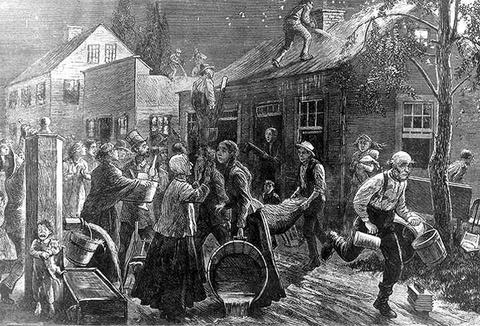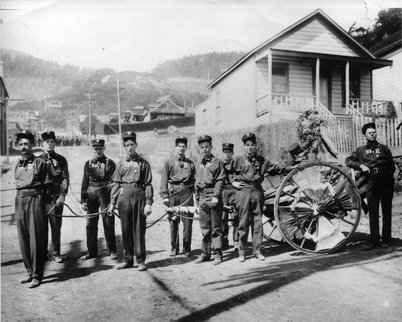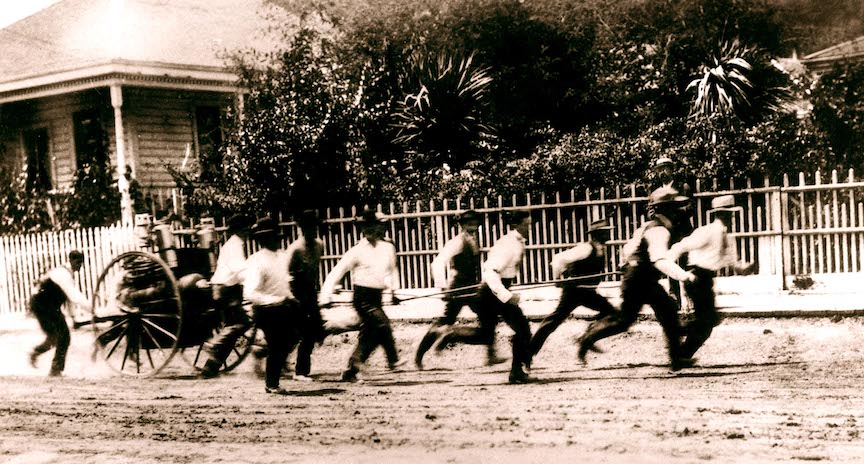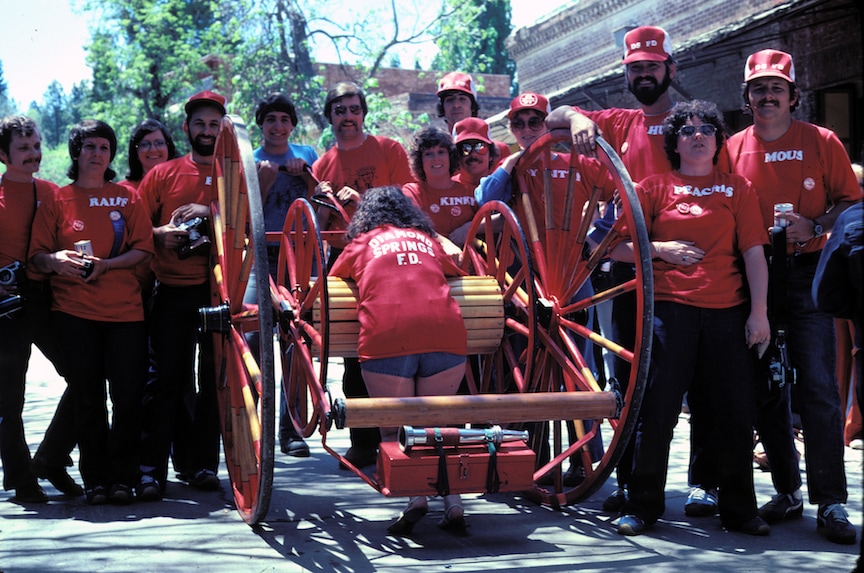The photo above was taken in the early 1900's in Larkspur, circa 1910.
The Larkspur Volunteer Fire Department is pictured pulling one of their hose carts along a dirt road.
The Larkspur Volunteer Fire Department is pictured pulling one of their hose carts along a dirt road.
|
Introduction
by Tom Forster Special thanks to retired Larkspur Chief William "Bill" Lellis for this story below of fire hose carts in Marin County, including friendly competitions held around the turn of the 20th century. These often featured the Petaluma and Healdsburg FD teams from Sonoma County, among others. Early fires in America were fought with bucket brigades, often ones that included all able bodied men, women, and children. Everyone needed to help put the fire out, or else the whole town might burn down. Several technological improvements would have to happen before that changed in large part. First, community water systems were needed with storage, gravity feed, and a means to get water out of the pipes. Initially this happened through holes being cut into wooden water mains, often during a fire, and then plugged after the fire was out. This is where the term "fire plug" came from. Later, above ground metal hydrants with threaded connections were developed. Above ground hydrants in America came about in the early 1800's, typically in larger communities that could afford them. Secondly, fire hose had to be developed, and later improved to give flexibility and the ability to be rolled easily. The hose was then used as an above ground piping system that could be easily deployed and then reloaded for future use. The first fire hose in the late 1600's in Europe was made of leather, initially stitched with one seam. Metal rivets would later be developed in the early 1800's, allowing much higher operating pressures. However, leather did not roll easily, could become quite stiff, and required high maintenance. Once cotton jacketed and rubber lined hose came about by the mid-1800's, the options for deployment and operating pressures increased. Third, once the hose had improved and fire hydrants or threaded connections were in place, the hose could be easily loaded in flat wooden carts, called hose wagons, or rolled onto hose cart reels and then deployed. Initially the carts were mostly made of wood, usually with metal axles, frame, and wheel treads. Over time, all-metal carts would be developed. Some are still manufactured today, for fire protection in industrial areas and often in developing countries, and for competitions that are often part of larger fire "musters", or firefighter gatherings for competition and fun. Combine the existence of many community hose carts and wagons with the competitive nature between fire departments and communities, and the 'race' was on. Sometimes the race would be who could get to the fire the fastest, within individual or neighboring departments, and that also led to non-emergency competitions for fun. |
|
|
Run for your life!
by Chief William "Bill" Lellis, Larkspur FD retired The heat was beating down on the crowd in Sausalito in the summer of 1908 on September 9th. They had been milling around the various community celebration and events for many hours. The excitement was building, since the main event of the day was about to take place. The announcement came - “...all companies this is your first call...” Fire department team captains could be heard calling their groups to assembly, making certain that each man knew his position and what was expected of him during the event. “Mill Valley team this your second call, please come to the starting line.” The team of the finest specimens of Mill Valley firemen slowly approached, bringing their apparatus gently to the line, making sure their hose cart reel lined up properly. They had been training every night for over a month, and they were the odds on favorites to win the trophy. “Gentlemen, take your start...” … the men bent over in order to gain the most power from their legs, as the starting gun would soon sound. Drops of sweat were falling off their brow, as the sun was showing no mercy… “team ready?”… the starter raised his hand, and in the flash of a second the starter sound was echoing off the building that lined the course. Nine Mill Valley firemen began to pull their hose cart, weighing well in excess of 1000 pounds, with every ounce of strength they could muster. The main event of the day had begun - the Firemen’s Hose Cart or "Reel" Races. Teams had traveled from as far north as Healdsburg and Petaluma in Sonoma County. Marin County was represented by teams from the fire departments in San Rafael, San Anselmo, Larkspur, Mill Valley and Sausalito. Twenty-nine and 3/4 seconds later, the Mill Valley Team completed their hose lay, water connection, and nozzle flow. This time would hold up as the best time of the day, with San Anselmo in second place with 32 seconds, Larkspur in third, followed by Sausalito and then San Rafael. The Mill Valley team would go on later that summer to race in San Jose at the Native Sons competition, featuring among others, teams from San Jose, Hollister, and Santa Clara. Unfortunately, Mill Valley lost their race when the hose jumped off the reel enroute and became entangled in the wheels. The other competitors would not allow Mill Valley another chance. The fireman's hose cart races were one of the first larger public athletic events in Marin. The local firemen would show their athletic skills before crowds of 1,000 people or more, racing to be the pride of the County. With family and loved ones watching with great admiration, the winners would receive a coveted silver trophy cup. |
|




























